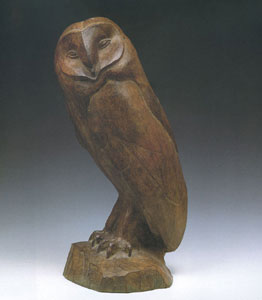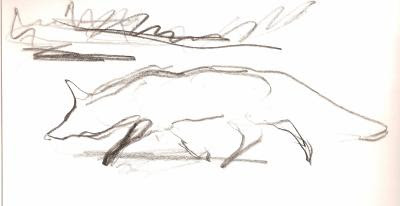Bronze 32 cm
Robert Hainard (Born in Geneva, 1906, lived a long time in the French Jura & died in 1999) is sadly not widely known outside of France & Switzerland. He is rightly considered one of Europe’s greatest ‘artiste-animalier’ (animal artists). His book « Les Mammifères Sauvages d’Europe »(Delachaux & Niestlé) remained the key field-book for decades, both for art lovers & lovers of wildlife alike & even today, his images of foxes, owls, boar & all kinds of animals remains a true bestiary, a celebration of wildlife.
Robert HAINARD
Gravure
His woodcuts reveal a knowledge of animals in their natural habit that can only be gained by long hours of close observation in the wild. This is not something that you can gain from copying from a book, a zoo or a photograph. His sketchbooks trace a lifetime of nights spent bivou-wacking under the stars & of whole days spent hidden in the undergrowth, watching the faune. He saw his first lynx at the age of 73, after 48 hours under canvas. Slowly letting the animals come to you, rather than you going chasing after them.
Artists and Ecology
Here is the work of a man who is no stranger to animals. As fine as anything you might find in Grotte de Chauvet or Lascaux.
Je n’ai personne à rendre responsable de ma passion de la nature. Elle est le fruit inévitable de mon goût d’être pleinement ( I have nobody to hold responsible for my passion for nature. It is the fruit of my taste to live live to the full ) Robert Hainard,(rough translations into English by myself)
Apparently there are over 30 000 sketches that remain. Here’s one of beaver that I esteem to be of genius.
Robert Hainard
Many of these sketches are drawn ‘sur la vif’ or asd the english say ‘on the hoof’. Literally whilst the animal is moving about. Just look at the wonderful sense of life & movement that these drawing exude!
Robert Hainard
Anyone who has tried this will know that this is amongst the most difficult of drawing techniques. It requires great powers of summarising an good understanding about the animal’s anatomy as well as identifying the typical way the animal moves typically whilst doing a routine gesture. Obiviously an element of caricaturising the animal helps.
>>>>>>>>>>>>>>>>>>>>>>>>>>>>>>>>>>>>>>>>
Blind Contour Drawing …. ‘Sur la Vif’
Adam Cope
The recipe is as follows : pick out an obvious edge or contour & follow along it with the point of the pencil in your drawing. That’s contour drawing … a simple line that follows the edges.
Now for the really difficult thing: do this ‘blind’ , that’s to say without looking at your drawing. You need to be able to plot the drawing in your mind’s eye. Hold it in your head, let your hand find the correspondence ( I suspect it’s a sensual way of knowing the world).
The reason why blind contour drawing is essential for drawing ‘moving targets’ is that you often have less than three or four seconds to get it down before the subject has moved on. You simply don’t have the time to cross-reference the marks made against the subject.
>>>>>>>>>>>>>>>>>>>>>>>>>>>>>>>>>>>>>>>>>>>>>>>>>>>>>>>
Robert Hainard – The Artist & Ecologist
He was also something of a scientific naturalist, having gained much experience & years of close observation in the field. His love for animals pushed him into action. For example, he was militant in speaking out against the embankment project of the Rhone & was involved in achieving a wildlife protection reserve, albeit a small part of the river banks. Sadly today the Rhone is very badly polluted & ‘denaturised’. Someone recently told me that the government has forbidden eating fish caught in the Rhone from Lyon downwards.
Si le savant n’est que scientifique, s’il n’est pas du tout intuitif, artiste, poète, mystique (…), il n’est qu’une brute scientifique…S’il ne s’accroche pas durement à l’analyse, à l’expérience, à l’action, le poète est une brute poétique.
If the learned person is only a scientific, if he is not all intuitive, artist, poet, mystic (…), he is only a coarse scientist… if he does no stick firmly to analysis, to experience, to action, the poet is only a coarse poet. – Le Miracle d’Être. Robert Hainard, Edtions Sang de la Terre, 1946 (rough translations into English by myself)
Other than his artwork, what I admire in the artist & the man Robert Hainard is his outspoken words in defense of the enviroment, making him one of the forefathers of modern-day ecology :
La destruction de la nature, que je ressens à la fois comme un predjuice personnel et direct, comme un acte de vandalisme et comme un sacrilège, pourquoi leur est-elle si légère, indifférente pour beaucoup? Il se diront peut-être plus résignés, moins gâtés ou moins egoïstes. Mais combien peuvent avoir leur sommeil troublé par une perte d’argent? Ce n’est pourtant qu’un transfert de puissnace, a leur détriment il est vrai, et je n’oublie pas mon egoïsme conscient et organisé. Mais encore, c’est une perte de puissance toute abstraite, indeterminée, la plus part réparable qui soit. – Le miracle d’être, Robert Hainard, Edtions Sang de la Terre, 1946, pp.73
The destruction of nature, which I feel both as a direct, personal attack, as an act of vandalism and as a sacrilege, why is it to so many others so light & so indifferent? Maybe they find themselves more resigned, less spoilt or less selfish? But just how many can have their sleep troubled by a loss of money? But this is only a transfer of power, to their detriment it’s true, and I don’t forget my conscious & organised selfishness. But again, it’s a loss of power, abstract & indeterment & for the most part, repairable. — Le miracle d’être, Robert Hainard, Edtions Sang de la Terre, 1946
(rough translations into English by myself)
La Société. de plus en plus, s’intéresse au développement de l’individu. Mais c’est encore une ruse(…) Elle l’enrichit, mais de plus en plus elle dirige ces enrichissements. Elle lui prépare les cadres, les casiers où toute cette matière viendra s’emballer sans trouble et sans à-coup. La réalité concrète, la nature est toujours nouvelle, étonnante, bouleversante.
Society, more and more, is interested in the development of the individual. But this is again a ruse… It enriches him but more & more it directs these riches. It prepares for him the contexts, the tills where all this material will come & sweep him away without trouble & without comeback. Concrete reality, nature is always new, stunning, moving.
>>>>>>>>>>>>>>>>
Le plus tragique, ce n’est pas le manque de nature, c’est qu’elle diminue. Je veux le renversement de la tendance. Et je veux non seulement le plus de nature possible, mais avec le plus possible de civilisation.”
The most tragic thing is not the lack of nature but that it is diminishing. I want to reverse this tendancy. And I not only want the most possible of nature, but also with the most possible of civilization.
>>>>>>>>>>>>>>>>>
Est-il sensé, pour maintenir pendant quelques générations un excédent démographique, de sacrifier (si c’était possible) toute vie sauvage, de défricher la Terre entière, de supprimer toute liberté, tout amour (car pas de liberté sans espace, ni d’amour sans choix) pour nous heurter bientôt, de toute manière, au bilan implacable : une vie pour une mort – eût-on défriché l’Amazonie, irrigué le Sahara, le désert de Gobi, urbanisé l’Antarctique ? Le pire fléau pour une espèce est la surpopulation. —Robert Hainard, Le monde plein, Ed. Melchior 1991. p35 (quoted by Philippe ROCH on https://www.pirassay.com/textes.php?id=11 )
These nightmarish thoughts, these darks thoughts …. are they true or are they chimeraic? Sometimes the words of artists are necessary to hear, even if they came from bad nightmares.
(Is it wise, to maintain for a few generations such a demographic excess, to sacrifice (if it were possible) all wildlife, to land-clear the whole Earth, to suppress all freedom, all love (because there’s no freedom without space, no love without choice) so as to send us clashing, in any case, against the implacable bottomline : a life for a death? Land-clear the Amazon, Irrigate the Sahara & the Gobi, Urbanise the Antartic? The worst plague for a species is over-population.” Robert Hainard, Le monde plein, Ed. Melchior 1991. p35 (quoted by Philippe ROCH on https://www.pirassay.com/textes.php?id=11 )
If an artist genuinely loves his or her subject matter then why shouldn’t he or she be concerned about it’s well-being?
Si j’aime tant ma vie de peintre, c’est qu’elle est à la fois immense et très centrée, car je vis la vie de la vaste nature, mais je la veux tenir entre mes mains par une conquête très âpre et personnelle. J’ai l’infini à ma portée, je le vois, je le sens, je le touche, je m’en nourris et je sais que je ne pourrais jamais l’épuiser. Et je comprends mon irrépressible révolte lorsque je vois supprimer la nature : on me tue mon infini.
For more on Hainard on the web :
Fondation Hainard
This site also generously has an ebook online in french : ‘Le Monde Plein by Robert Hainard’
wikipedia.fr – Robert Hainard
>>>>>>>>>
Read more artists & ecology in this blog:
Artists & Ecology #1 – Festival Flore Faune
Artists and Ecology #2 – Robert HAINARD – how to ‘blind contour draw’
Artists & Ecology #3 – Constable, Corn & the Destruction of Hedgerows
Artists & Ecology # 4 – Paintings of Potatoes, Semances & Homage à José Bové
Artists & Ecology # 5 -Le Dropt, Castillonnés , a green corridor?
Artists & Ecology # 6 – No Space for Nature in the Countryside? Wendell Berry








